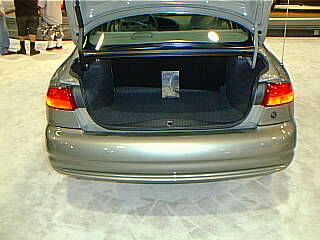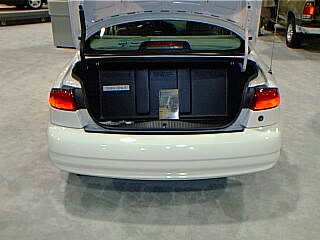
Home - AFV Events - Auto Shows - 1999 Anaheim Auto Show
The 1999 California International Auto Show was held 14-18 October 1998 at the Convention Center in Anaheim, CA, and alternative-fuel vehicles were displayed by several of the automakers present. Of course, Honda had their EV Plus there and GM was showing the EV1 in the Saturn display, since both of these are currently available to consumers (in some parts of the country, and for lease only). The alternative-fuel vehicles being marketed to fleets by these two makers, the natural-gas-powered Honda Civic GX and the Chevrolet S-10 electric pickup, were not on hand, though I have seen both at other auto shows; Toyota, however, had brought the electric version of their RAV4 compact sport-utility vehicle, which is currently for sale to fleets:

Toyota also had their Prius parallel hybrid-electric passenger car on hand; you could easily tell this was not a model that's available in the United States: it has right-hand drive!

The Prius has been available in Japan for almost a year, and they are selling like hotcakes, primarily because they get 66 miles per gallon on the Japanese test cycle and gasoline costs something like $4 per gallon there. (It doesn't hurt that they are being sold significantly below the cost of their small-volume production, but as with other electric vehicles, the manufacturer is accepting some up-front losses while building the market to where they can begin to profit from the economies of large-scale production.) The car's small gasoline engine simply shuts off at low speeds, allowing the electric motor to handle most city traffic without tailpipe emissions, and it turns back on when speeds pick up or when it is needed to recharge the battery. In US EPA testing, the fuel economy of the car was significantly lower than in Japan, about 50 MPG; this is because the test here includes less low-speed creeping in heavy city traffic than the Japanese test, and those are the conditions under which the car was designed to give its greatest benefits. Toyota is currently reengineering the car for US driving conditions, with the idea of getting the fuel economy back up into the 60's, and they are thinking of selling it here in a couple of years.
Dodge also had a hybrid-electric vehicle on display, the Intrepid ESX2 concept car; this vehicle has a small, efficient three-cylinder diesel engine which supplies the average power demand of the car, with batteries to give a boost where needed or to provide zero-emission performance in urban driving.

Dodge has re-entered the market for compressed natural gas (CNG) vehicles with a variant of their 1999 full-size van; this is a descendant of my van, though Dodge sat out the 1997 and 1998 model years because of difficulty getting components, especially fuel tanks. This vehicle is marketed to fleets (I may have the only one in private hands...), but if you buy a 1999 Dodge/Chrysler minivan with a 3.3-liter engine (except in California, Massachusetts, or New York), you will be among many people who own a flex-fuel ethanol alternative-fueled vehicle! These minivans can run on any mixture from 85% ethanol/15% gasoline (E85) to 100% gasoline.
Ford has also introduced ethanol flex-fuel capability as standard equipment on its 1999 Ranger pickups with a 3.0-liter engine, and optionally on Taurus cars with a 3.0-liter engine. These Fords, unlike the Dodge/Chrysler E85 minivans, are available in all 50 states, though the ethanol capability is at present not usable in California, for example--there isn't a single E85 refueling station in the state, as far as I know (such stations are concentrated in the Midwest farming states). There are quite a few methanol (M85) stations in California, but as far as I am aware no automaker is currently building new light-duty vehicles that can use this fuel (though thousands sold in recent years are still in use).
Ford currently offers the widest range of alternative-fueled vehicles of any automaker, and their most impressive array is in CNG vehicles: there are dedicated and bi-fuel F-series trucks and E-series vans, a dedicated Crown Victoria full-size car (popular with police departments and taxi companies!), and a bi-fuel Contour compact car. I had a chance to see a conventional gasoline Contour next to the CNG-capable version at the Ford display; aside from the CNG filler port on the opposite side of the car from the regular gasoline tank inlet, the most obvious difference was in the trunks:


I placed a Ford Alternative Fuel Vehicles brochure against the forward wall of the cargo areas to give you an idea of depth; in the second picture, you can see that the CNG tanks, located in the trunk of the CNG model,take up a significant chunk of the cargo volume. There's still enough left to be useful, of course, but this is one reason that automakers have concentrated on trucks for their CNG models: there's more real estate under the body or in the cargo areas to put tanks! Of course, if the CNG capability is designed into the vehicle, rather than being added onto it later, the tanks can be integrated into the structure so as to use space more efficiently: the GM EV1 has its batteries built into the framework of the car, and GM has shown a CNG variant of the EV1 where the tanks are put in place of the batteries, so as not to cut into cargo or passenger space.
So, to summarize, I think we can say that the alternative-fuel vehicles at this auto show demonstrate that such vehicles are entering the mainstream. Electric vehicles are being marketed to consumers as well as to fleets, and ethanol capability is available on some 1999 models without the buyer even having to ask for it. As production volumes grow and CNG refueling stations become more numerous, the price and engine-durability advantages of natural gas will become increasingly apparent to consumers as well as fleets; Ford has produced a few Expedition large sport-utility vehicle prototypes with CNG capability, and that's certainly a sign that they're looking at the consumer market in addition to the fleet market that buys their CNG vans. Keep your eyes open--things are cookin'!
 Back
to AFV Events Page
Back
to AFV Events Page Back
to Fueling Station
Back
to Fueling Station Site
Map
Site
Map Contact
Me
Contact
Me All content copyright 1998-2024 by Mark Looper, except as noted. Reuse of my copyrighted material is authorized under Creative Commons Attribution 4.0 International license (CC BY 4.0).
![]()
![]()
new 19 October 1998